‘Urban Safety' - Cities for children: A right to play and grow
- Shashank Oswal

- May 28, 2021
- 10 min read
This blog represents adolescents' perspective in mapping their experiences and desires towards living in a safe, vibrant, and healthy built environment. Children categorized under the meager percentage of the population are often neglected by the current planning paradigm while designing for spaces and cities. The amount of time spent by children outdoors, their ability to get around independently, and their contact with nature are strong indicators of how the city functions sustainably and safely. Interestingly, this aspect is captured by an Architect and urban designer Shashank Oswal graduated from Kamla Raheja Vidyanidhi Institute of Architecture. Shashank is currently practicing in the city of Pune. His research dwells in ‘children-friendly cities’ where it addresses the critical challenges in metropolitan cities and sets underlying principles in designing for coherent and systematic children-friendly design measures.
“Children are a kind of indicator species. If we can build a successful city for children, we will have a successful city for all people” – Enrique Penalosa, Mayor of Bogota.
The constant growth and development of cities have gained greater importance in architectural, economic and ecological development. The city is composed of urban systems as the main networks and is interconnected with the secondary networks through its users and diverse urban elements of the city making it coherent. A balanced urban environment should be developed considering the basic needs of every citizen, with gender and age factor from an infant to a senior citizen. With the increase in the rate of urbanization the urban scale grows which directly links with the increase in the obscurity of public areas. Looking at the changes that the city undergoes through both tangible and intangible, clearly indicates a lack of design rules and criteria which develops urban disorder and leads to the formation of increasingly fragile and unsafe public spaces.
On a broader scale, the safety of people within the city is one of the crucial factors for maintaining the urban vitality of a city. Urban vitality can be maintained by well-planned dense functional spaces, the intensity of pedestrian activity on the streets which would generate adequate social interaction and activities which would ensure the feeling of being safe within the urban environment. Safety is one of the most important aspects of spatial quality, it affects the behavior of an individual which is directly linked to the surrounding built form. The build-up of safe cities is not a global concern but has become the basic goal for sustainable development. As far as the spatial quality for urban safety is concerned it addresses both physical as well as social environment. The aspect of safety lies within the fundamental psychological need of humans that is highly influenced by the place and spaces that are used by the individual itself.
The design of streets and the spatial network which makes up a modern city are no longer safe havens for the citizens. The issue of safety and security has become particularly an important part of life as it is directly linked with various individuals within the city. The perception of safety is quite subjective as it varies from each individual of different gender and of diverse age groups within the society. The safety of individuals within public space is governed by both - physical (urban morphology) and psychological (sense of safety) aspects which makes it difficult to define safety precisely. As per Abraham Maslow’s hierarchy safety is placed in the second position of importance, immediately after satisfaction of the primary biological-physiological needs.

A safe city planning concept can be achieved when the physical factors are combined with the spiritual and psychological behavioral study. Physical factors which include parameters regarding urban safety and psychological factors would include parameters responsible for the sense of safety.

Urban safety:
"Urban safety is a phenomenon in which a person feels no damage to carry out his normal behavior and activity without any damage from any environmental disturbance" (United Nations, 2016). It is not only a personal state and safety for the population, it is a complex notion, defined on the basis of several factors and formed in a given territory of the inhabited area. Urban safety is a combination of factors, including urbanization, architectural and ecological ones, which create favorable and safe living environments (Rastyapina, 2015). The environment and places that favor such social abnormal activities are formed within these urban spaces which aid such activities. Identifying the factors and elements affecting the insecurity, safe and unsafe spaces, social security and sense of safety is considered as one of the fundamental prerequisites for citizens in planning and urban designing and has a significant role in government strategic planning. In the rush to promote high-density urbanism, certain zones are inadvertently created which are inhospitable for the citizens. These types of areas are exposed to high risk and lack of safety factors makes certain user groups within the urban environment highly vulnerable. Especially to those user groups like children, senior citizens, physically disabled and women.
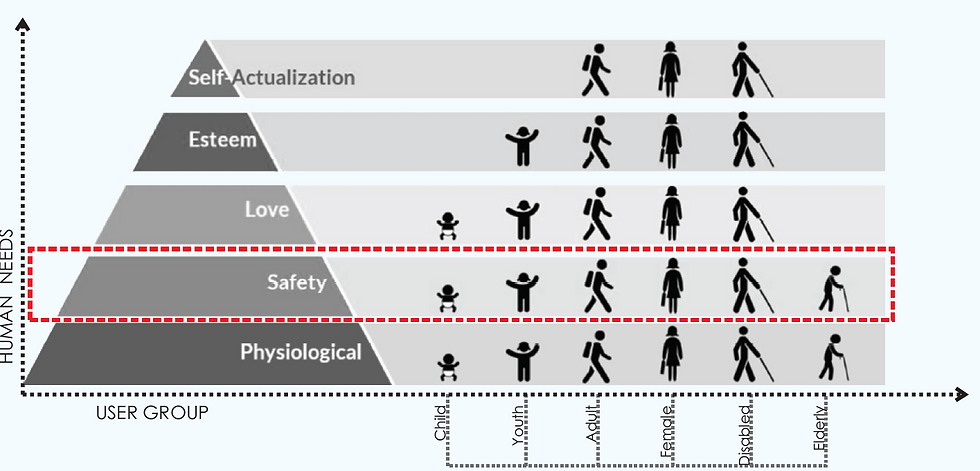
“A city-level (safe city) campaign promotes a city where all urban inhabitants – regardless of socio-economic status, gender, race, ethnicity or religion – are able to fully participate in the social, economic and political opportunities that cities have to offer. Engaging the urban poor, youth, and women in particular at all levels of planning and decision-making is key to creating a safer city” - (UN-Habitat, 2015a, p. 10).
The current practices within our cities regarding safety are only limited to internal building safety, the safety planning for public spaces outside the building is lacking. Overall control over the urban space environment in each hierarchy is missing which makes it incapable of forming a complete and safe public space.
Defense for Safety: A theoretical approach
In order to ensure safety and control in urban space, urban design is carried in terms of the physical environment. Famous scholars have put forth important theories and methods regarding activity, surveillance and territorial definition. Safety on streets and neighbourhood was originated from Jane Jacob (1961), which was further taken ahead by Oscar Newman in his idea of Defensible Space and CPTED which was coined by C. Ray Jeffery.
Jane Jacob's “The Death and Life of Great American Cities” in 1961 emphasized the impact of urban space on criminal behaviour and protection of citizens' safety. It could be done by the clear division between public and private spaces and “eyes on the street” with natural surveillance (Jacob, 1960). Her theory advocates the use of high-density mixed-use development, which are areas with residential and commercial use only to stimulate street traffic. Jacobs stressed that safety can be achieved in terms of natural surveillance by neighbourhood and multi-use of crowded streets. She argues that increased street traffic would not only help the neighbourhood to flourish socially and economically but would also act as informal policing and also deter any anti-social activities.
Oscar Newman refined the theory of Jane Jacobs, emphasizing on surveillance and territoriality. Newman explicitly put forward the theory regarding crime and the built environment was the defensible space. In Defensible Space: Crime Prevention Through Urban Design in 1972, Newman explicitly put forward the urban design strategy of defensible space theory responding to crime problems and emphasized the integration of four factors of territoriality, natural surveillance, image, and milieu. Later, criminologist C. Ray Jeffery coined and formulated CPTED (Crime Prevention through Environmental Design) after analyzing the relation between the space environment and anti-social activities (Jeffery, 1971). The theory of CPTED is similar to Newman’s Defensible Space theory, it is based on anticipating the thought processes of a potential offender and creating an environment that discourages follow-through.
It is based on the principle of effective use and proper design of the built environment and public spaces in the neighbourhoods can lead to the reduction of crime and feeling of unsafe in an environment and helps in improvising the quality of life.
Kevin Lynch has also pointed out that if a space is chaotic and lacks readability it causes difficulties to a person’s spatial orientation and resulting in environmental fear. A desirable environment with legibility can reduce the possibility of the labyrinth and gives the users a psychological sense of safety, which is generally observed in children’s (Lynch, 1960).
As mentioned in the above theories, aspects like public surveillance, territoriality and built environment should be considered in order to develop a safe city. The built environment should be developed in order to ensure porosity and active streets which ensures public surveillance which helps to develop eyes on the street and also a sense of safety within their territory.
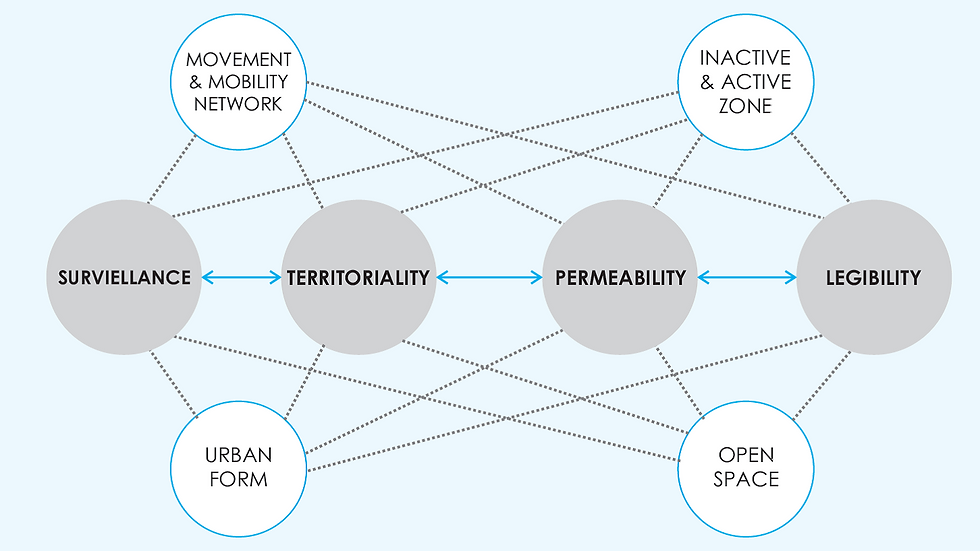
Urban safety is complicated but should be the basic requirement for urban existence and development. The modern planning paradigm has defined urban safety which is always associated with any kind of safety in relation to a man in any area within the city, public spaces which have more or less access without restriction. In recent time’s senior citizen and gender-specific planning is taken into consideration but infants, children’s and adolescents are still not integrated within the planning norms. Therefore, the planning of a child-friendly city plays an important role to undertake issues regarding health and well-being and firmly induce safety and security within our urban environment.
Child-friendly City planning:
“A child-friendly city (CFC) is a city, town, community or any system of local governance committed to improving the lives of children within their jurisdiction by realizing their rights. In practice, it is a city, town or community in which the voices, needs, priorities and rights of children are an integral part of public policies, programs and decisions” (UNICEF 2015).
Based on the United Nations Convention on the Rights of the Child, children are defined as people between the age group of 0-17 years. Designing for urban childhood proposes a child-friendly approach to urban planning, helping to build a city that works for everyone. A child-friendly city is a city in which children and adolescents can grow up in a pleasant, responsible, safe and dynamic way (NIUA, 2016). But in our cities, children can’t be left alone due to the danger of fast-moving vehicles and the ominous fear of being abducted or assaulted and the simplest of all, the danger of getting lost. These factors develop the factor of fear within the children and also make them perceive certain things as unsafe within their surrounding urban environment.
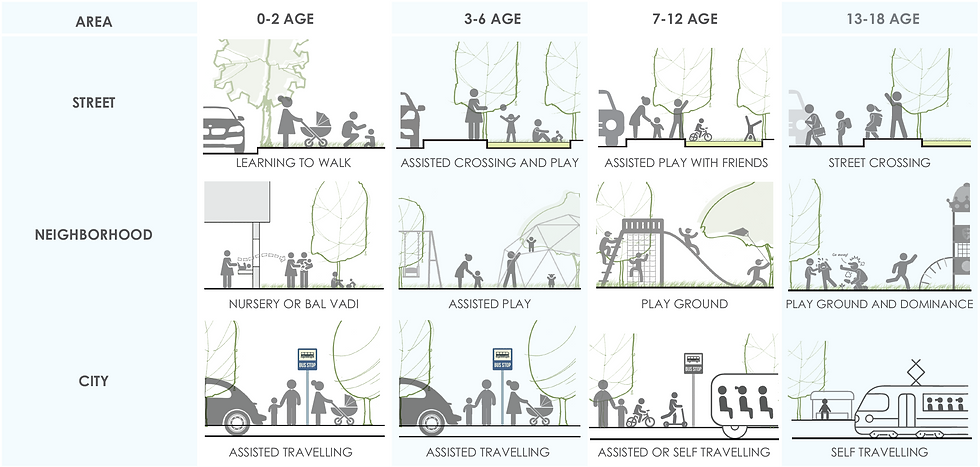
These seem like insoluble problems, but they can be partially be tackled by enlarging those zones where small children are to left roam alone in a well-protected zone of adult activities and ways of life. The way children interact with the environment has a significant impact on child’s physical, mental and social health, looking at the way our cities are planned children are often neglected in the planning paradigm (McAllister, C.2008). In conventional planning practices, design and planning implication for the children is only limited to the location and size of the school in the development plan and on a smaller scale, playgrounds and parks are only provided as urban open spaces. There is lacking in terms of planning “for” the children and planning “with” the children. The broader factors which need to be considered are safety, accessibility, green space, health and well-being, and integration (McAllister, C.2008). Since children would be comprising a significant portion of the current population their safety and health within the urban environment should be a primary concern in designing and planning neighbourhoods and cities. In other words, a child-friendly urban area should be created in which children should feel safe and also be considered an equal part of the society along with other individuals.

Safety for Children: Planning measures.
Safety is one of the major concerns for a child-friendly city. Concern about traffic, crime and other hazards result in a climate of fear within the parents and children result in over-regulation of childhood activity. Urban spaces pose a great threat to children in terms of increased traffic density, decreased open spaces and safety problems due to disordered housing caused by rapid and unplanned urbanization. Due to this children are deprived of open areas and streets, where they move freely making them most vulnerable to these situations. In order to develop a child-friendly urban environment, certain parameters should be taken into consideration to solve the problem of traffic safety and social safety. Traffic safety would help to develop child-friendly streets because streets are one the most used public space by children.

Currently, the streets are overpowered by vehicles instead of bicycles and pedestrians. Whereas, streets have the potential issues as place, not just as space for children to learn and play. The speed of traffic and amount of space prioritized to people dictate whether a child feels safe while cycling and walking to school, playground or taking public transport during rush hours. On the other hand, the aspect of social safety can be endured with the existence of people on street and by having porosity to develop the missing relation of built form with the street. “A properly used street is a safe street. An empty street is generally unsafe” (Jacobs, 1993,p.54).
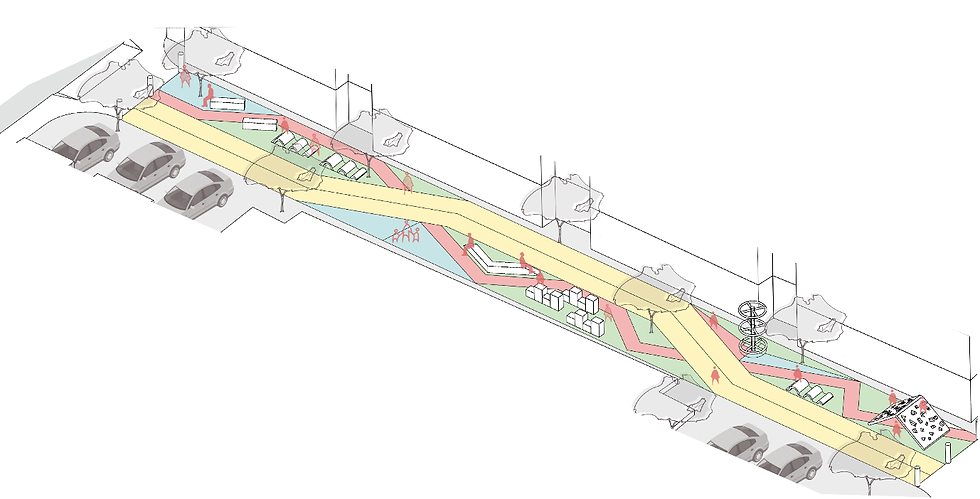
The issue of accessibility to public spaces should also be taken into the perspective of providing social safety. Children should have abundant access to public spaces like parks and play spaces to engage in social connections and develop self-confidence. Green spaces also have the potential safety hazards, increased accessed means there is the potential of exposing children to a wider variety of danger. In such small details regarding the design and placement of building with entrances and windows can create a sense of natural surveillance like “eyes on the street” and create a sense of security.
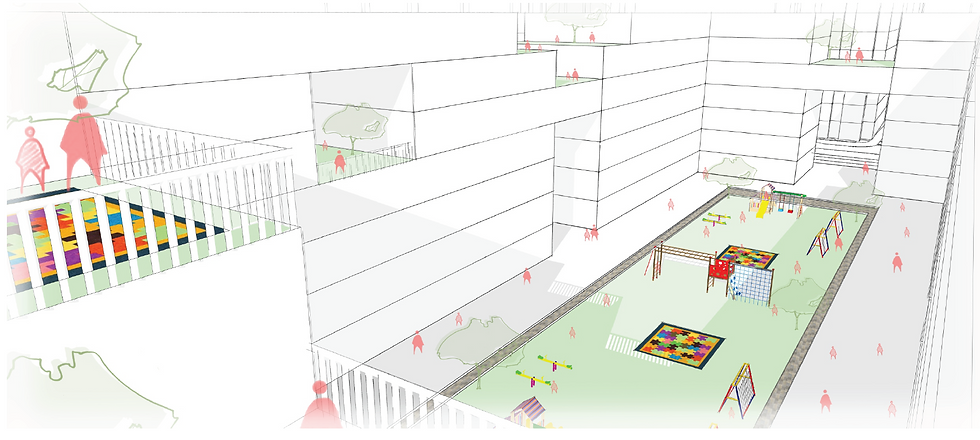
In addition, the concept of safety for children should be placed in the center of cities which can be executed not only with physical and social parameters but also with strong urban policies which are child-centric in order to develop a safe neighbourhood. The research looks towards developing a child-centric public realm and their daily activities with response to the urban built environment. India is home to 39 percent of its total population comprising of children, planning for children should be taken as a primary concern for the development of the cities. The basic lacking of consideration of children within the planning process can be looked into through interviews and mapping of spaces that turn out to be unsafe for them due to multiples factors like crime, heavy traffic movement, fear. A safe environment should be developed by involving various age group as each person of different age and gender uses the city differently due to the influencing
effect of the city’s environment.
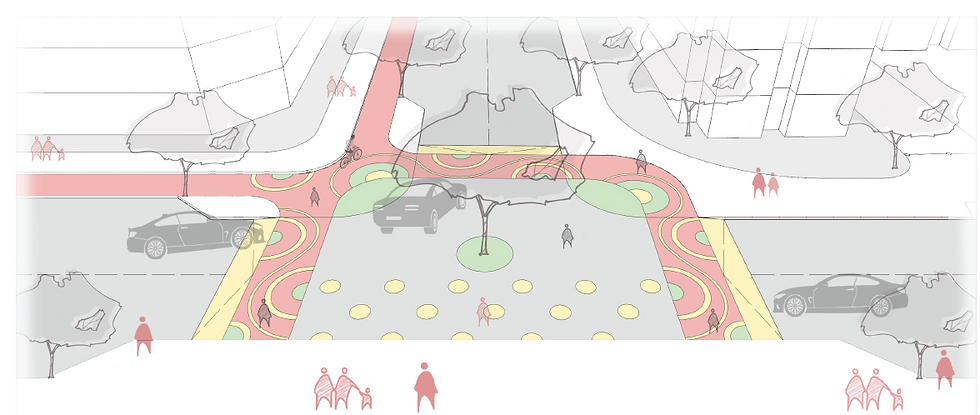
Lastly, the theories of Jane Jacob and Newman have provided a framework in assessing the urban spaces, the sensorial journey of a child how they use micro spaces and their psychological definition of safety would lead towards inclusive and children-friendly cohesive urban planning. Children today are the future for our safer, liveable and healthier cities, hence their safety and psychological health must be the center stage of our development. I hope you liked this blog. Do share and comment for your opinions.



Comments